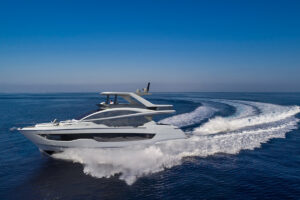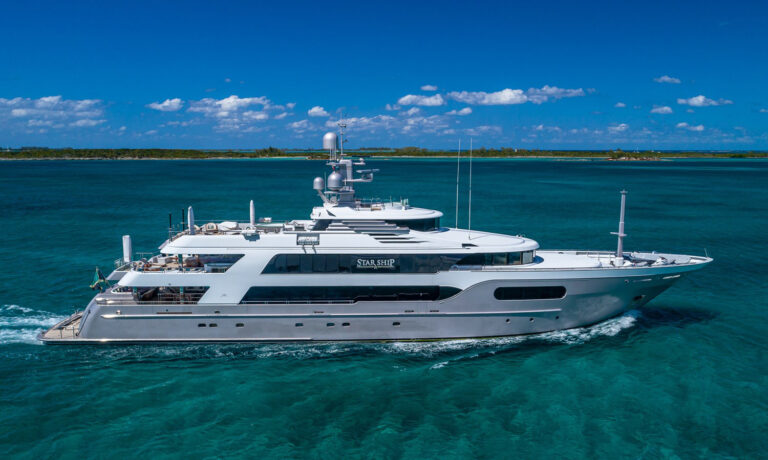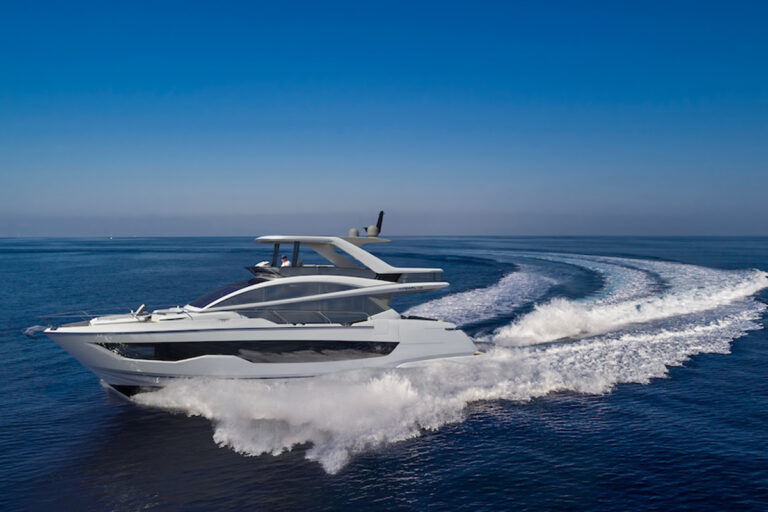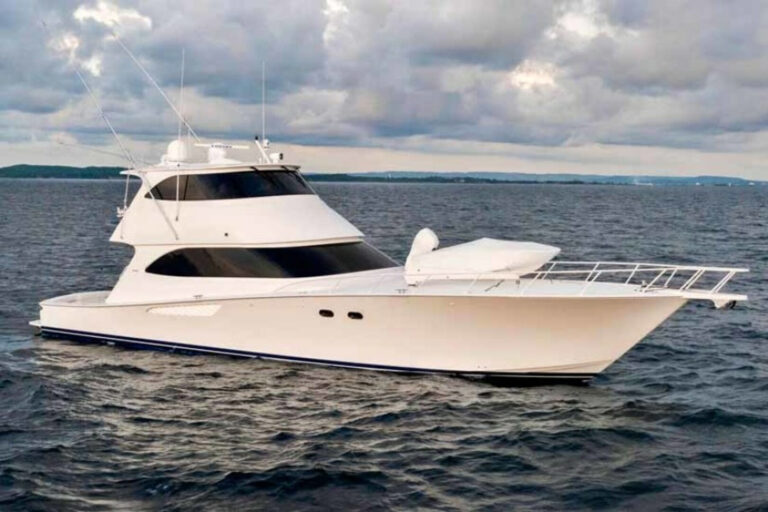Silverton launched its first convertible design, a 34-footer, in 1978 and delivered 1,200 during the next 20 years. The builder also found success with a 37-footer launched in 1981, so it’s no surprise a loyal cadre of Silverton owners had great expectations for the 38 Convertible.
“It is amazing how connected our owners are with our product”, said Sean Berrie, chief designer at Silverton. “They had lived with the 37 and had definite opinions of what they liked.”
Before pen touched paper, the 38’s design was hashed out in focus groups. There was strong demand for a more upscale product, according to Berrie, and Silverton responded with interior upgrades such as raised-panel, solid cherry cabinetwork.
The boat’s level of fit and finish is impressive. Cabinet doors are fitted with recessed European hardware, and door and drawer faces are solid cherry, as is the saloon table. Drawers have wood sides and bottoms, and powder-coated metal slides. The galley is finished with Corian countertops and hardwood flooring. Innerspring mattresses are standard, as are lighted, cedar-lined hanging lockers.
Her interior layout is one of the best I have seen on a small convertible. The saloon has a domestic-style sofa that converts to a double berth at the push of a button, and a built-in entertainment center is positioned so the television can be viewed from the sofa or the dinette forward.
Owners on the West Coast and in the Northeast insisted on natural ventilation, so the 38 has opening saloon windows; a screened, sliding saloon door that can be secured open; and deck hatches in the master stateroom, shower and head.
The galley is two steps down and has dual-voltage refrigeration, a three-burner cooktop, a microwave/convection oven and a sink with a cutting board. Many owners requested an electric oven, which Silverton provided along with plenty of stowage.
Forward, the master stateroom’s berth is a bit high, but the design makes sense, allowing space for an honest queen-size mattress and a built-in washer/dryer. I also like the split-head arrangement, with the shower to port and the MSD to starboard. The master also includes two hanging lockers, a bank of drawers and a built-in entertainment center with a television.
A portion of the guest stateroom is tucked beneath the dinette, but the space is surprisingly large for a convertible this size, particularly considering the space allocated to the galley.
Convertibles, by nature, are versatile designs, and Silverton has a fix on the balance its customers prefer.
“Eighty percent of our 42 Convertible owners cruise and 20 percent fish”, Berrie said. “We expect the same will be the case with the 38.”
To that end, the 38’s sweptback silhouette is far from the traditional fare hardcore anglers gravitate toward, but she is an up-to-date refinement of the 37. I suspect fans will find the family resemblance appealing.
Her cockpit has stowage/fishboxes in the sole and a molded-in stowage box in the transom. The “Fish Pak” option includes rodholders, rocket launchers on the bridge rail, raw- and freshwater service in the cockpit, and a bait prep center with a sink and tackle drawers. There is space for a refrigerator or an ice maker in the bulkhead console. Rod stowage is in the saloon overhead. Whether fishing or cruising, I would get the optional Glendinning Cablemaster shore cord system. I have had my fill of lugging shore cables on and off the dock.
The 38 includes Silverton’s cockpit-bridge staircase, a feature Berrie said has been a hit with owners, particularly women. I guess I’m old-fashioned, but I prefer ladders, which are easier to navigate in a seaway and seem a more practical use of space.
Sight lines from the helm are good, and the helm and companion seating is arranged so guests can pass behind the skipper without being disemboweled. The helm seat has a flip-up bolster that should provide good support in rough seas or while trolling. Bench seating forward can be lifted for access to stowage within the console, which has dual controls and space for several large displays and electronic paraphernalia. There is also a molded-in electronics box in the fiberglass hardtop.
The 38 is laid up by hand with a combination of stitched and woven reinforcement and polyester resin. A vinylester skin coat is used below the waterline to reduce the chance of blistering. The hull bottom is a solid fiberglass laminate, and Coremat is used in the hull-side laminate to minimize reinforcement print-through. Fiberglass stringers and web frames are formed over wood, and bulkheads are plywood. Engines are mounted on steel foundation beams. The hull/deck joint is bonded, mechanically fastened and fiberglassed from the inside, where accessible. Bilges are finished, and glasswork appears well-executed.
Machinery space is accessible from the cockpit and the saloon. Access to service points appears good, although the water tanks outboard of the engines crowd things a bit. There are engine access and removal hatches in the saloon sole.
The generator is beneath the cockpit, isolating noise and vibration from the accommodations, but owners would be wise to watch for corrosion in this potentially damp environment. The generator can be reached through the engine compartment or via the lift-out fish/stowage box in the cockpit. The entire cockpit sole can be removed for more complete access to the generator and for access to the aluminum fuel tanks. Main 12VDC and 120VAC electrical panels and battery switches are in the saloon, where they are easily accessible.
Our test boat had a pair of 450 hp Caterpillar 3126Bs, one of a variety of gas and diesel packages offered. We hit a top speed of 28.7 knots. Cruising at 2400 rpm, our speed was 22.9 knots and the Caterpillar electronics indicated a fuel burn of 34 gallons per hour. At 2600 rpm, our speed was 26 knots with a 39 gallon-per-hour fuel burn. This is just about ideal performance for a boat of this size and type, and these engines would be my choice. They are the highest horsepower diesels offered.
The 38’s hull is suited for offshore work with a relatively fine entry and a deadrise of 17 degrees at the transom. I exercised her offshore and found her comfortable and dry in the 3-foot seas. She was responsive, and the Cats delivered power without complaint.
Base price with gas power is $246,145. This is a bargain, so it’s no surprise Silverton estimates 65 percent of those who buy the 38 will choose gas.
Still, those serious about fishing or cruising would be far better off in the long run with diesel power. Our test boat, powered with 450 hp Caterpillars and a long list of options including an 8kW generator, air conditioning and electronics, totaled $415,450. Even so, the 38 is still a lot of boat for the money.
Contact: Silverton Marine Corp., (856) 825-4117; fax (856) 825-2064; www.silverton.com.









